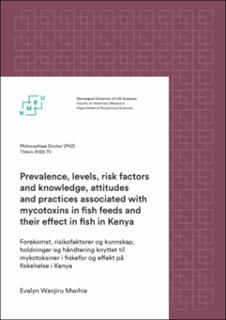| dc.description.abstract | Mycotoxins are low molecular weight chemical by-products of fungal metabolism. They are frequently detected in human foods and animal feeds in the tropics due to environmental conditions such as, warm and humid climate and management practices favouring fungal growth, development, and mycotoxin production. Interest in mycotoxins is due to their potential adverse effects on human and animal health and the economic cost they pose on local, regional and international trade of plant and animal products. Mycotoxins have carcinogenic, teratogenic, mutagenic, hepatotoxic, nephrotoxic, genotoxic, and cytotoxic effects in human beings and animals leading to morbidities and/or mortalities. To protect consumers from these undesirable health effects, many countries and regulatory bodies have set maximum limits (ML), indicative limits (IL) and/or guidance values (GV) for major mycotoxins to regulate the presence of mycotoxins in foods and feeds. These limits contribute to economic barriers in local, regional and international trade especially in food products from the tropics.
This research work was a cross-sectional study aiming at identifying and quantifying mycotoxins present in fish feeds and their potential effects on fish health in selected counties in Kenya, as well as assessing knowledge, attitudes and practices related to mycotoxin contamination among relevant stakeholders. It entailed visits to 204 fish farms, 25 fish feed retail outlets and 11 fish feed manufacturing plants where questionnaires were administered and samples of fish feeds, feed ingredients and farmed fish were collected. The questionnaires were analysed using statistical packages while fish samples were assessed for gross and microscopic lesions. Feed samples were analysed for mycotoxin presence using enzyme linked immunosorbent assay (ELISA) and high-performance liquid chromatography-high resolution mass spectrometry (HPLC-HRMS).
The first work package sought to find out if aflatoxins were as prevalent in fish feeds as they were in foods and other animal feeds in Kenya. It also aimed at assessing the potential adverse health effects associated with mycotoxin exposure in fish (Paper I). In the last two decades, several outbreaks of aflatoxicosis in human beings and domestic animals as well as occurrences of aflatoxins in foods and feeds have been reported in Kenya. A total of 68 (84%) feeds sampled tested positive for aflatoxins on ELISA, ranging from <1.8 to 39.7 µg/kg with a mean of 7.0 - 8.3 µg/kg and a median of 3.6 µg/kg (Paper I). The work package also addressed potential adverse effects associated with aflatoxin exposure. Fish from 5 rainbow trout farms (42%) had typical lesions associated with aflatoxin exposure such as, swollen abdomens containing enlarged livers with white or yellow nodules, which microscopically, had large dark basophilic hepatic cells with hyperchromatic nuclei in irregular cords (Paper I). However, it was impossible to infer causality since this was a cross sectional study conducted at one point in time therefore not giving an indication of a sequence of events, that is, whether aflatoxin exposure occurred before, after or during the onset of the disease outcome (aflatoxicosis).
Following identification of aflatoxin presence in fish feeds, this research sought to find out what two main stakeholders in fish production, that is, fish farmers and fish feed retailers, knew, believed, and practiced that could influence aflatoxin contamination of fish feeds and subsequent exposure to fish (Paper II). This second work package revealed low cumulative knowledge, attitudes, and practices (KAP) scores by fish farmers (62%) and feed retailers (67%) which was indicative of inadequate contribution towards prevention and control of aflatoxin contamination. Fish farmers had significantly less knowledge about aflatoxins (71%; p < 0.001) as well as less favourable practices (52%; p = 0.003) than feed retailers (94% and 71% respectively). Additionally, fish farmers’ KAP scores were significantly correlated (rs = 0.445, 0.506 and 0.495) (Paper II) suggesting that improving fish farmers’ aflatoxin knowledge would improve their attitudes and practices to favour prevention and control of aflatoxin contamination of feeds and subsequent exposure to fish.
Having identified and quantified aflatoxins in the fish feeds, the third work package sought to determine if other mycotoxins were present in fish feeds in Kenya as well as to estimate fish dietary exposure to these toxins (Paper III). Using HPLC-HRMS, 29 of 40 (73%) mycotoxins tested for were identified where 97% of the samples tested positive for at least one mycotoxin. Mycotoxins with the highest prevalences were enniatin B (91%), deoxynivalenol (76%) and fumonisin B1 (54%) while those with the highest maximum levels were sterigmatocystin (<30.5 – 3517.1 µg/kg); moniliformin (<218.9 – 2583.4 µg/kg) and ergotamine (<29.3 – 1895.6 µg/kg). Mycotoxin co-occurrence was observed in 87% of the samples. Fish dietary exposure estimates ranged between <0.2 and 43.4 µg/kg body weight per day (Paper III).
This research work shows evidence of mycotoxin presence and co-occurrence in fish feeds and feed ingredients in Kenya. Fish exposure to these levels of mycotoxins over an extended period of time may lead to harmful health effects either singly or co-occurring through possible additive, synergistic or antagonistic toxic effects. Measures to reduce mycotoxin contamination in fish feeds should be taken to avoid mycotoxicosis in fish and subsequent exposure to humans and other animals through residues. Similarly, the research has shown that major stakeholders, that is, fish farmers and feed retailers, have inadequate knowledge, unfavourable attitudes and conduct practices that could potentially contribute significantly to mycotoxin, specifically aflatoxin, contamination of fish feeds and exposure to fish. Stakeholders need to be educated about mycotoxins to influence their attitudes and practices which contribute towards prevention and control of mycotoxin contamination of feeds and exposure to fish. | en_US |

